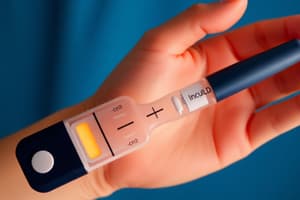Podcast
Questions and Answers
What is a key indicator of diabetic ketoacidosis (DKA)?
What is a key indicator of diabetic ketoacidosis (DKA)?
Which symptom is commonly presented by older children and adolescents with DKA?
Which symptom is commonly presented by older children and adolescents with DKA?
What consequence can result from overly aggressive fluid resuscitation in DKA patients?
What consequence can result from overly aggressive fluid resuscitation in DKA patients?
What occurs during the presentation of patients with DKA?
What occurs during the presentation of patients with DKA?
Signup and view all the answers
What is a typical characteristic of DKA diagnosis in infants?
What is a typical characteristic of DKA diagnosis in infants?
Signup and view all the answers
What is a finding associated with diabetic ketoacidosis?
What is a finding associated with diabetic ketoacidosis?
Signup and view all the answers
What is an appropriate maximum daily fluid administration in DKA treatment?
What is an appropriate maximum daily fluid administration in DKA treatment?
Signup and view all the answers
Which of the following is NOT a common finding in children presenting with DKA?
Which of the following is NOT a common finding in children presenting with DKA?
Signup and view all the answers
What is the most common cause of mortality in pediatric diabetic ketoacidosis?
What is the most common cause of mortality in pediatric diabetic ketoacidosis?
Signup and view all the answers
What potential complication may arise from the osmotic diuresis in diabetic ketoacidosis?
What potential complication may arise from the osmotic diuresis in diabetic ketoacidosis?
Signup and view all the answers
Why should surgery not be delayed in cases of diabetic ketoacidosis?
Why should surgery not be delayed in cases of diabetic ketoacidosis?
Signup and view all the answers
What effect does insulin deficiency have on potassium levels during diabetic ketoacidosis?
What effect does insulin deficiency have on potassium levels during diabetic ketoacidosis?
Signup and view all the answers
What role does hyperosmolality play in the management of potassium levels during diabetic ketoacidosis?
What role does hyperosmolality play in the management of potassium levels during diabetic ketoacidosis?
Signup and view all the answers
What should be considered when using succinylcholine in diabetic ketoacidosis patients?
What should be considered when using succinylcholine in diabetic ketoacidosis patients?
Signup and view all the answers
What gastrointestinal losses contribute to potassium deficiency in diabetic ketoacidosis?
What gastrointestinal losses contribute to potassium deficiency in diabetic ketoacidosis?
Signup and view all the answers
Which electrolyte disturbance commonly occurs alongside hyperosmolality in diabetic ketoacidosis?
Which electrolyte disturbance commonly occurs alongside hyperosmolality in diabetic ketoacidosis?
Signup and view all the answers
What is the incidence of cerebral edema in patients with diabetic ketoacidosis?
What is the incidence of cerebral edema in patients with diabetic ketoacidosis?
Signup and view all the answers
Study Notes
Diabetic Ketoacidosis (DKA) Overview
- DKA is characterized by hyperglycemia with blood glucose >200 mg/dL and metabolic acidosis (venous pH <7.3, plasma bicarbonate <15 mEq/L).
- 38% of DKA cases occur during the initial diagnosis of type 1 diabetes mellitus in children.
- Common symptoms include abdominal pain, polyuria, polydipsia, and fatigue.
Clinical Presentation in Different Age Groups
- Older children and adolescents typically exhibit:
- Increased urination due to glucose-induced osmotic diuresis.
- Excessive thirst due to increased urinary losses.
- Weight loss, nocturia, daytime enuresis, and candidiasis.
- In infants, diagnosis is challenging due to lack of toilet training, leading to unnoticed polyuria and polydipsia.
- Common findings in infants include decreased energy, irritability, weight loss, and signs of dehydration.
Physical Findings and Complications
- Patients often present with:
- Severe dehydration and tachycardia.
- Urine containing ketones and glucose.
- Hyperventilation as a compensatory mechanism for metabolic acidosis.
- Risk of cerebral edema due to aggressive fluid resuscitation.
- Incidence of cerebral edema is about 1% but accounts for 57% to 87% of DKA-related pediatric deaths.
Treatment Protocol
- Rehydrate with isotonic fluids, monitoring serum osmolality.
- Fluid administration should not exceed 4 L/m² per day to prevent complications.
- Timely surgical intervention is crucial to correct metabolic derangements during emergencies.
Electrolyte Management
- DKA leads to urinary losses of potassium due to osmotic diuresis and gastrointestinal losses from vomiting/diarrhea, risking hypokalemia.
- Insulin deficiency impairs potassium entry into cells, and hyperosmolality causes potassium to exit cells, potentially raising serum potassium levels.
- Use succinylcholine with caution due to its potential to increase potassium levels, especially in cases of acidosis-related hyperkalemia.
Studying That Suits You
Use AI to generate personalized quizzes and flashcards to suit your learning preferences.
Description
This quiz explores the definition, symptoms, and epidemiology of diabetic ketoacidosis (DKA), particularly focusing on its association with type 1 diabetes. Test your knowledge on the clinical presentation and the prevalence of DKA in children and adolescents. Gain insights into the critical aspects of managing this serious condition.




